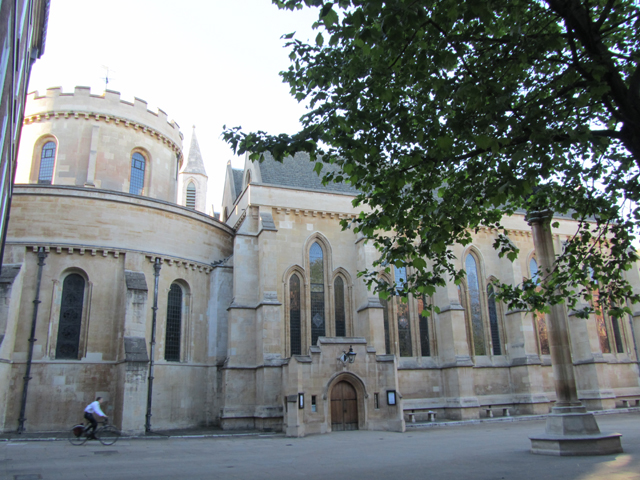The Temple Churchyard (City of London)
Brief Description
St Mary's Church was built in the late C12th by the Knights Templar who moved here from Holborn. The round church was first consecrated in 1185; a larger chancel was added and its consecration in 1240 was attended by Henry III. The Knights Templar were dissolved in 1312 and in 1324 their Temple property was given to the Knights of the Order of St John, who subsequently leased it to a society of students of the common laws of England. This later formed into two societies, those of the Inner and the Middle Temple, who in 1608 were granted the freehold in perpetuity for use as a place of study and residence. The Temple Church escaped the Great Fire of 1666 but was badly damaged in 1941 and restored in 1954. North of the church a paved churchyard has a number of tombs, beyond this is a raised area laid out as a small garden containing the C18th memorial to Iohannes Hiccocks, the tomb of Oliver Goldsmith, and gravestones set into the paving.
Practical Information
- Previous / Other name:
- St Mary's Churchyard
- Site location:
- The Temple, access via Temple Lane/Tudor Street
- Postcode:
- EC4Y 7BB
- What 3 Words:
- trade.fonts.times
- Type of site:
- Churchyard
- Borough:
- City of London
- Open to public?
- Yes
- Opening times:
- Churchyard garden and Church Court unrestricted. Church: open daily but check website for details.
- Special conditions:
- Facilities:
- Events:
- Concerts, talks and events in church
- Public transport:
- Tube: Blackfriars, Temple (District and Circle). Bus: 4, 11, 15, 23, 26, 76, 172
- Research updated:
- 01/04/2011
- Last minor changes:
- 19/07/2023
Please check with the site owner or manager for latest news. www.templechurch.com
Full Site Description
St Mary's Church in the Temple serves the Inner and Middle Temple (q.v.) and was built by the Knights Templar in the late C12th. The Order purchased land here and moved from Holborn, where they had originally established themselves on the site of the present Southampton Buildings (q.v.) where remains of foundations were discovered in 1999/2000. At that time the circular nave and porch were built and the church was consecrated by Patriarch Heraclius of Jerusalem in 1185. In c.1220 building of a new and larger chancel commenced, its consecration in 1240 attended by Henry III. The nave contains a series of C13th effigies of Knights in Purbeck marble, which were restored when the church itself was restored in both the C19th and in the C20th following damage in World War II. The Knights Templar were dissolved by the Pope in 1312 and the Temple property passed through the hands of a number of noblemen until 1324 when all previous lands of the Knights Templar were given to the Knights of the Order of St John. The Knights conveyed the Temple to Hugh le Despencer, favourite of the King, at whose death it reverted to the Crown but it was later granted once again to the Knights, who leased it to a society of students of the common laws of England, which eventually formed two societies, those of the Inner and the Middle Temple.
At the Dissolution of the Monasteries the Temple passed to the Crown although the law students maintained their lease and in 1608 James I granted the freehold to the Benchers of the Temple in perpetuity for use as a place of study and residence. Temple Church escaped the Great Fire of 1666 but was refurbished by Wren in 1682. It was badly damaged in 1941 and restored by Carden and Godfrey in 1954.
North of Temple Church is a paved area of churchyard with a number of tombs, bounded to the north by wall and railings beyond which is further raised area of former churchyard laid out as small garden with one tree. There remain a couple of tombs including a memorial to Iohannes (John) Hiccocks (d.1726) and the tomb of Oliver Goldsmith (d.1774) near the Goldsmith Building, and some gravestones set into the paving. Adjacent to the church is the Master's Garden (q.v.), entered from Church Court with a path leading through the garden to the Master's House.
Sources consulted:
Simon Bradley & Nikolaus Pevsner, 'The Buildings of England, London 1: The City of London', 1997 (1999 ed.); George Godwin & John Britton 'The Churches of London: A history and description of the Ecclesiastical Edifices of the Metropolis, Volume I', London, 1838; London Diocesan Advisory Committee for the Care of Churches data; history on church website
Further Information (Planning and Conservation)
- Grid ref:
- TQ312810 (531230,181070)
- Size in hectares:
- 0.0628
- Site ownership:
- Temple Church
- Site management:
- Date(s):
- C12th onwards
- Designer(s):
- Listed structures:
- LBI: Temple Church. LBII: statue of John Hiccocks
- On National Heritage List for England (NHLE), Parks & Gardens:
No- Registered common or village green on Commons Registration Act 1965:
No- Protected under London Squares Preservation Act 1931:
No
Local Authority Data
The information below is taken from the relevant Local Authority's planning legislation, which was correct at the time of research but may have been amended in the interim. Please check with the Local Authority for latest planning information.
- On Local List:
- No
- In Conservation Area:
- Yes
- Conservation Area name:
- Temples
- Tree Preservation Order:
- No
- Nature Conservation Area:
- No
- Green Belt:
- No
- Metropolitan Open Land:
- No
- Special Policy Area:
- Yes - Thames Policy Area
- Other LA designation:
- None
Photos
Temple Church of St Mary, June 2010. Photo: S Williams
Click a photo to enlarge.
Please note the Inventory and its content are provided for your general information only and are subject to change. It is your responsibility to check the accuracy.











